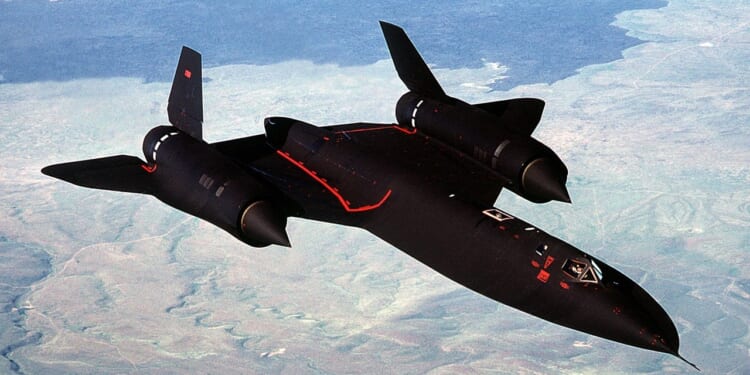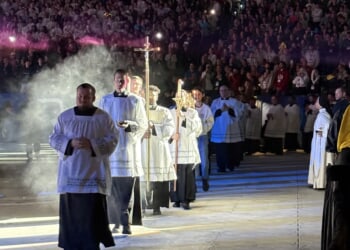The SR-71 Blackbird, the fastest aircraft ever built, was ultimately done in by the Air Force’s most notorious and intractable enemy: budget cuts.
The Lockheed SR-71 Blackbird remains one of the most awe-inspiring machines ever built—an aircraft that looked like science fiction even in the 1960s, and still does today. Capable of sustaining flight above Mach 3 and at an altitude of 85,000 feet, the SR-71 could outrun every missile ever fired at it and cross continents in under two hours. The aircraft was a technical marvel.
Yet despite its unmatched performance, the SR-71 was retired in the late 1990s—for reasons unrelated to performance, but rooted instead with the hard numbers of cost and strategy in a shifting strategic environment.
The SR-71 Blackbird’s Specifications
- Year Introduced: 1966
- Number Built: 32, not including prototypes
- Length: 107 ft 5 in (32.74 m)
- Wingspan: 55 ft 7 in (16.94 m)
- Weight: ~170,000 lb (77,111 kg) MTOW
- Engines: Two Pratt & Whitney J58 turbojet/ramjet-mode engines (~32,500 lbf / 144.6 kN thrust each with afterburner)
- Top Speed: Mach 3.3+; absolute recorded speed ~2,193.17 mph (3,529 km/h)
- Range: ~2,900 nmi (~3,337 mi, ~5,371 km) ferry; mission range varies with refueling
- Service Ceiling: ~85,000 ft (~25,900 m)
- Payload: Strategic reconnaissance — high-resolution optical cameras, infrared sensors, side-looking airborne radar (SLAR), ELINT/COMINT suites; no offensive armaments
- Aircrew: 2 (pilot and reconnaissance systems officer)
Why the US Air Force Needed the SR-71 Blackbird—Then Didn’t
When the SR-71 entered service in the 1960s, it filled a crucial niche: surveilling deep behind enemy lines, in the era before satellites could do so effectively. The aircraft was a child of the Cold War, using speed and altitude to gather intelligence. As intelligence aircraft went, it was a blunt instrument; it lacked stealth features, simply using its jaw-dropping speed and altitude capacity to blast past anti-air threats.
But by the 1980s, the SR-71’s place in the strategic landscape had changed. The US had built constellations of recon satellites capable of photographing any target on Earth with exquisite detail and predictable revisit times. The satellites could not be shot down, didn’t require putting pilots behind enemy lines, and delivered data securely. In short, the satellites were more reliable—and far safer—than the SR-71.
Aside from the rise of the satellite, the SR-71 itself posed staggering operational demands, threatening the program’s long-term viability. Every flight required hours of pre-launch fueling with a specialized fuel, JP-7, which featured unique ignition chemicals and required fleets of specialized tanker aircraft. The SR-71 would leak specialized fuel on the ground, until the skin heated enough, at supersonic speeds, to expand and seal the tank in flight. And after each sortie, the SR-71 required tens of thousands of man-hours of maintenance—which was so complex that only a handful of crews and technicians in the entire world were qualified to perform.
The US was willing to justify such expense and attention at the peak of the Cold War, when defense budgets were inflated, and before satellites could do the job. But in the post-Vietnam era—and certainly in the post-Cold War defense climate, where budgets constricted and risk tolerances decreased—the Air Force struggled to justify a platform that cost millions of dollars per mission just to deliver the same photographs that any spy satellite could take.
The SR-71 Was Outdated by the 1990s
Accelerating the SR-71’s inevitable retirement was the aircraft’s decline in intelligence value. The SR-71 was designed for film and analog systems; after a mission, the aircraft had to land safely, then the film had to be processed, and then the intelligence had to be analyzed—a cycle that was far too slow in a fast-moving crisis. By the 1990s, digital sensors and secure satellite relays made near-instant transmission possible from orbit, or from unmanned systems. The SR-71’s world-class speed was no longer decisive, given that the intelligence yielded could not reach decision makers until after decisions had already been made using easier-to-collect intelligence.
The nail in the coffin, so to speak, was the increased political risk of operating the SR-71. The Cold War was over. And adversaries were fielding better radar networks, with longer-range surface-to-air missiles. This meant that the SR-71 was no longer quite as out of reach as it had been—and was increasingly susceptible to sparking a political incident, as the shootdown of U-2 pilot Francis Gary Powers had in 1960. In the post-Cold War moment, the intelligence community wanted to shift towards cover, deniable, or space-based collection assets—and away from the contrail-blazing Mach 3 dynamo, the SR-71, one of the most remarkable machines ever built.
About the Author: Harrison Kass
Harrison Kass is a senior defense and national security writer at The National Interest. Kass is an attorney and former political candidate who joined the US Air Force as a pilot trainee before being medically discharged. He focuses on military strategy, aerospace, and global security affairs. He holds a JD from the University of Oregon and a master’s in Global Journalism and International Relations from NYU.
Image: Wikimedia Commons.


















